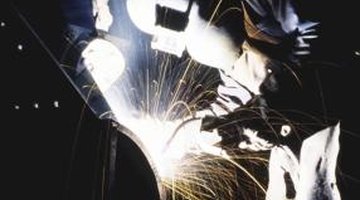How to Weld With Innershield Wire NR-233
Innershield NR-233 welding wire is a wire considered to be a good choice for novice and professional welders due to its all-around usefulness for welding a variety of mild steel alloys and the fact that it provides an easy-to-control weld puddle. NR-233 is a self-shielded flux-core wire used primarily for structural welding and can be utilized in any position, including overhead welding.

Step 1
Set up the welder for the thickness of metal you need to weld. This information may be included on the inside panel of the welder where the welding wire is fed or it may be in the welder's owner's manual. Most welders use different settings for amperage and wire feed speed.
Step 2
Position the parts to be welded in the manner in which they will be joined, holding them together with welding clamps.
Step 3
Attach the negative ground clamp to the work piece so there is unobstructed flow of electricity from the ground clamp to the welding electrode. If the parts being welded are painted, you will have to clean some of the paint off with a wire brush to achieve good weld penetration.
Step 4
Extend the welding wire out of the tip of the welding gun approximately 1/4 of an inch. Turn on the welder and then position the Innershield NR-233 welding wire just above where you will begin welding. Keep in mind when you select a place to begin your weld that it is best to push the weld puddle rather than pull it.
Step 5
Lower your welding helmet, then pull the trigger of the welder. When the Innershield NR-233 wire comes into contact with the metal being welded, the electrical arc will form and the welding process will begin. You will see a puddle of liquid metal begin to form at the base of this arc. Use a stitching or tiny circular motion to push this weld puddle across the seam being welded. The width of the weld you produce should remain a consistent 1/4 inch to 3/8 inch to produce the best quality weld.
Step 6
Release the trigger on the welder and pull the welding gun away from the metal that has been joined. Clean the excess slag off the weld with a wire brush and allow the weld to cool off naturally. Quenching the part could lead to tiny fractures in the weld or in the steel that was welded, compromising the strength of the part.
References
- Lincoln Electric: Innershield NR-233 Welding Wire
- "Welder's Handbook, Revised: A Guide to Plasma Cutting, Oxyacetylene, ARC, MIG and TIG Welding"; Richard Finch; 2007
- "Welding Fundamentals"; Roger Jellison; 1995
Tips
- Innershield NR-233 is a self-shielding wire that can be used not just for industrial applications, but for hobby applications, as well.
Warnings
- Wear safety gear whenever you weld with any type of welding wire. The intense brilliance of the arc produced by welding can lead to severe damage to your eyesight.
Writer Bio
Don Kress began writing professionally in 2006, specializing in automotive technology for various websites. An Automotive Service Excellence (ASE) certified technician since 2003, he has worked as a painter and currently owns his own automotive service business in Georgia. Kress attended the University of Akron, Ohio, earning an associate degree in business management in 2000.
Photo Credits
- Ablestock.com/AbleStock.com/Getty Images
More Articles



